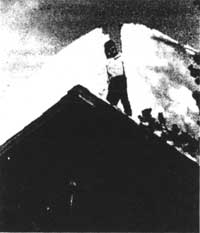The rangers on the patrol this year were Paul Turner, Verne Bertsch, and Richard Ward. We left Park Headquarters at 8:00 A.M., in the Sno-Cat and proceeded out the East Entrance road to the Vidae Falls truck trail. We then traveled this road to the point where it starts around the flank of Dutton Ridge. Here we parked, took time for a cup of coffee, put on our skis and started around the ridge.
The day was beautifully clear, so the three of us were busy taking color shots of Union Peak, Klamath Lake and other interesting features. About one and a half hours after leaving the Sno-Cat we reached the point where the rest of the trip was downhill. Here we stopped for lunch, as it was almost noon. We also took several pictures of Mt. Scott with its covering of snow. We always look forward to that stretch of the trip from Dutton Ridge to the Lost Creek Cabin as it is downhill all the way. (I make the above statement only from the standpoint of “going over” because “coming back” the slope seems ten times steeper up than it does down.) We put on our skis after lunch and started down. Luck was with us as we had almost ideal snow conditions. At first we encountered a few patches of ice, but we soon worked our way out of it onto a stretch of powder snow about three inches seep, arriving at the cabin early in the afternoon.
The first job was to dig out the stove pipes and to shovel the snow from the cabin door. Finding the stove pipes was a big job in itself. We knew approximately where they were, so we started digging. After removing about seven feet of snow we found the ridge; then we started down the slope of the roof and, as the snow had pushed the pipe over, we had to search for it. This took some more digging. By the time the pipe was dug out and straightened we had worked up an appetite. While the stove pipes were being dug out, one man gained access to the door of the cabin and laid the fire. At the signal that the pipes were clear, the fire was started.
 Ranger Bertsch standing in the initial cut in the snow. |
The cabin was like a deep freeze when we first went inside, but after a few minutes it started to warm up and all thoughts turned to food. Each man picked his specialty and started to cook. The food had been stored late in the fall in mouse-proof containers and, although many of the items were frozen, it was in good condition. After a good meal, the dishes were washed, more snow shoveled, beds were made, fires were built up, and then to bed.
Next day the routine was as follows: Up in the morning, after some discussion as to who would get up and build the fires and start breakfast (hot cakes and bacon). After breakfast snow removal. We divided the roof into sections and shoveled trenches all the way to the roof, eave to eave and over the top; then using a saw, sections were cut off and rolled clear of the roof. This soon becomes back breaking work. The snow removal continued all day, with short breaks for coffee and lunch.
As soon as it started to get dark we had dinner of wieners, potatoes, peas, biscuits with butter and jam, and peaches – – all washed down with lots of coffee. We all “hit the sack” early – – to rest our sore and tired muscles.
The morning of the third day we were up bright and early, ate breakfast and finished the roof. We had an early lunch, put out the fires, locked the building, put on our skis and started back up the steep mountainside to the Sno-Cat. For this climb we used “seal skins”, a mohair material fastened to the ski bottoms that allows a skier to climb a slope without sliding back. After several hours we reached the top of Dutton Ridge and had a candy bar and a cup of coffee. We only had a little way to go now, with some excellent downhill skiing. Soon we saw the Sno-Cat – – and it was a welcome sight. Ranger Turner started the motor, we had another chocolate bar, and then settled back for a comfortable ride back to Headquarters.

